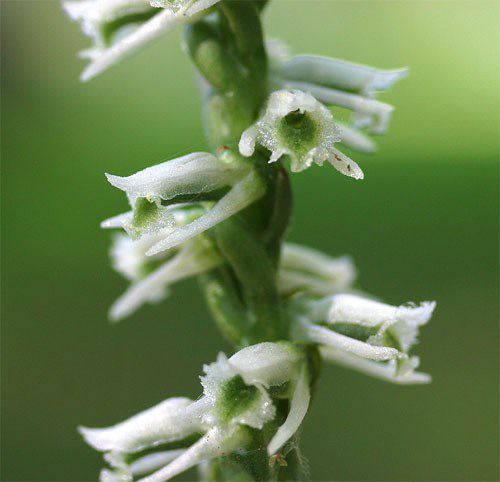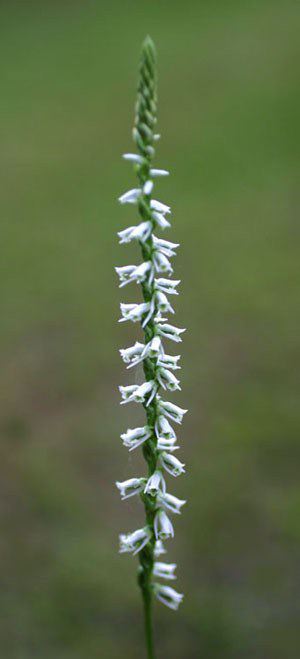|
|
|||
|
THIS WEEK at HILTON POND |
|
ORCHIDS IN THE GRASS The word "orchid" brings to mind images of a showy, expensive flower, perhaps worn by you or a date at your high school prom. For the most part, such decorative blossoms had their origins in tropical areas of the world, where many grow as epiphytes on rain forest trees--often at considerable heights. Exotic orchids have inspired expeditions to distant rain forests or equatorial mountaintops, where field botanists have lost their lives--and heads!--as they sought new varieties in lands protected by indigenous peoples. Alas, these explorers need not have paid the ultimate price in search of orchids, for we have some growing right on the lawn at Hilton Pond Center.  It often surprises people to learn that there are many kinds of orchids in temperate North America--more than 65 varieties in the Carolinas alone!--and that in the U.S. and Canada these native plants live on the ground rather than on trees. Most of our terrestrial orchids have small flowers that, from afar, don't look all that spectacular. This week we came across an exceptionally nice orchid specimen while mowing a small expanse of lawn at Hilton Pond Center. Competing with the crabgrass was a 18-inch-tall white spike that proved to be Slender Ladies' Tresses, Spiranthes gracilis . This plant's common name comes from the way its blooms spiral around the stalk, reminiscent of how women braid their hair. Spiranthes simply means "spiral flower"; gracilis pertains to the thinness of the flower spike (right), a significant characteristic because most other species of Ladies' Tresses are much more robust. Orchid flowers have three outer segments (sepals) and three inner segments (petals); the bottom petal, or "lip," often droops down. The interior reproductive parts (stamens and pistil) are fused into a "column"--a structure unique to the Orchidaceae (Orchid Family). Pollen from the stamens is embedded in a waxy mass (pollinium) that an insect must transport en masse to be deposited on the sticky end of the pistil. After contact, a pollen tube grows into the pistil toward the ovary, where fertilization actually occurs. In some orchids, the flower structure is so complex this pollination process can only be implemented by one particular species of insect that is just the right size and shape to receive and carry the pollinium. The Slender Ladies' Tresses pictured here is a variety that blooms August through September in fields and meadows across the Carolina Piedmont and Mountain provinces. Each of its flowers has two noticeable white sepals that are sharply pointed, three white petals that form a tube, and a lip with a conspicuous green stripe. Another type of Slender Ladies' Tresses--one with a yellow lip--blooms in spring from the Coastal Plain of North Carolina south to Florida. We'll never see the latter variety here at Hilton Pond Center, but we're happy with our little green-lipped orchid--mostly because it's an interesting plant but also because its presence gives us good reason to cut a little less grass on the front lawn. If you enjoy "This Week at Hilton Pond," please help Support Hilton Pond Center for Piedmont Natural History. It's painless, and YOU can make a difference! You may wish to consult our Index of all nature topics covered since February 2000. |

 Up close, however, the individual blossoms are every bit as pleasing to the eye as that big pink or white corsage from the prom.
Up close, however, the individual blossoms are every bit as pleasing to the eye as that big pink or white corsage from the prom. Flowers of Slender Ladies' Tresses are relatively simple in configuration, but since they're only a quarter-inch long it is safe to assume their pollinator(s) must be pretty small. At least two bumblebees--a long-tongued species (Bombus pensylvanica) and a short-tongued (Calliopsis andreniformis)--are reported to visit this plant in search of nectar.
Flowers of Slender Ladies' Tresses are relatively simple in configuration, but since they're only a quarter-inch long it is safe to assume their pollinator(s) must be pretty small. At least two bumblebees--a long-tongued species (Bombus pensylvanica) and a short-tongued (Calliopsis andreniformis)--are reported to visit this plant in search of nectar.
